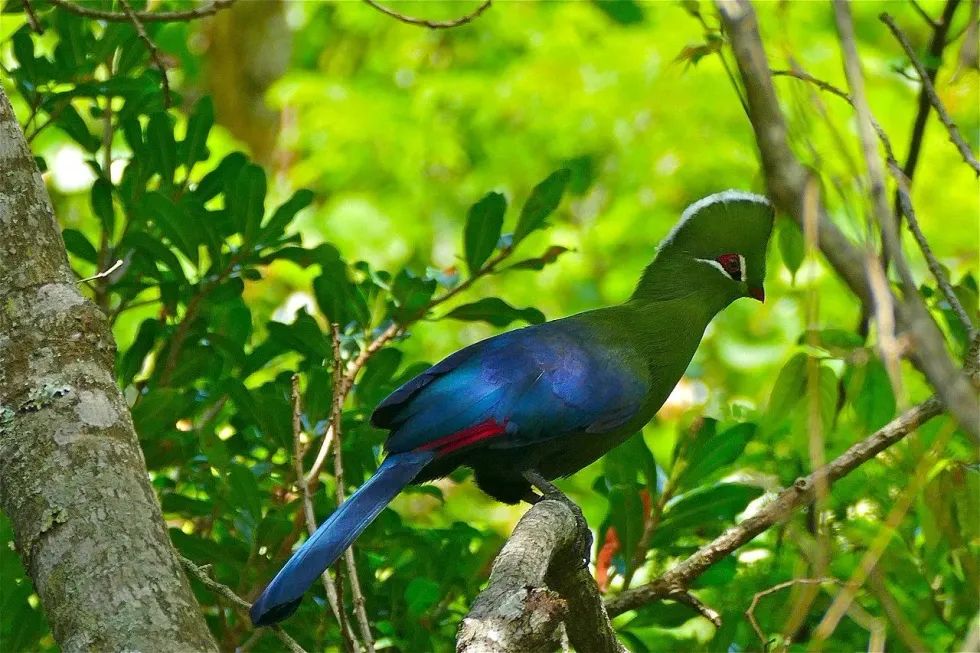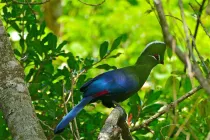Discover another set of captivating birds - the enticing, lively, and colorful turacos of Africa. Apart from their unique go-away calls, the turacos are the only birds who are the proud owners of actual red and green color feathers.
Their whole body is covered with beautiful green feathers, and the underside of the wings has red feathers. With flexible and energetic outer toes, they can revolve forward and backward.
In South Africa, the Knysna turaco is famously known as Knysna Loerie. It is a large bird species native to Mozambique, South Africa, and Swaziland. It is regarded as a subspecies of the Green Turaco of West Africa.
The turaco is a resident breeder in eastern and southern South Africa's mature evergreen forests. This distinct bird comes with attractive vibrant green plumage.
One of its unique characteristics is the white tip on the top of its crest. The eyes are brown, and the eye-ring is deep red. A white line is also extended beyond the eyes.
Aren't these birds enchanting? Read on to know more about the Knysna turaco. Hoping to nurture your knowledge more about birds? We have covered facts about the Eared Grebe and Golden-winged Warbler.
Knysna Turaco Interesting Facts
What type of animal is a Knysna turaco?
Turacos belong to the family Musophagidae in which the go-away birds and the plantain eaters are also included. In South Africa, the Turacos are often compared to the go-away birds and are popularly known as Loeries. They live in the mature evergreen forests of southern and eastern South Africa and West Africa.
What class of animal does a Knysna turaco belong to?
The Knysna Turaco (Tauraco corythaix) is a bird. It belongs to the class Aves and the family Musophagidae.
How many Knysna turacos are there in the world?
The population size of the Knysna Turaco (Tauraco corythaix) is not known as there are many species of turacos. According to the IOC World Bird List (version 10.1), there are 23 species of Turaco in six genera.
Where does a Knysna turaco live?
The Knysna Turaco (Tauraco corythaix) is a species of turaco that lives in the woods and mature evergreen forests of southern and eastern South Africa, as well as Swaziland. They are also found in Mozambique and all of the Capes - Northern Cape, Eastern Cape, and Western Cape.
What is a Knysna turaco's habitat?
The resident breeder of mature evergreen forests in southern and eastern South Africa and Swaziland is the Knysna turaco (Tauraco corythaix). They love the dense and broad-leaved evergreen forests. The Knysna Lourie is a non-migratory bird. The Knysna turaco is energetic during the day and is usually seen flying between forest trees or leaping from one branch to another.
Who do Knysna turacos live with?
The Knysna Turaco (Tauraco corythaix) is a social bird species often moving around in small noisy flocks. They build their nest alone or in pairs during the breeding season. They are territorial and usually stay and move around with their family groups or pairs.
How long does a Knysna turaco live?
In captivity, the Knysna Lourie bird is known to live for 30 years, while in the wild, it is not known.
How do they reproduce?
The Knysna Turaco (Tauraco corythaix) follows monogamous breeding. Their breeding time varies according to location. The female turacos lay only two eggs. The eggs are laid in a shallow platform nest made from sticks and placed in a tree or clump of creepers.
Both parents incubate the eggs for 20-24 days. For 22 days the hatched chicks stay in the nest. They fly when they are 28 days old. The young bird species become independent when they are three weeks old.
What is their conservation status?
The conservation status of the Knysna Turaco (Tauraco corythaix) around the world is ‘Least Concern’.
Knysna Turaco Fun Facts
What do Knysna turacos look like?
The Knysna Turaco is a large Turaco bird species belonging to the African Musophagidae bird population. It has a 15-16 in long tail.
The body is covered with green feathers, and in flight, the Knysna Turaco shows conspicuous crimson primary flight feathers, a pleasing sight to watch. The head comprises a crest that is tipped with white.
The eyes are brown and surrounded by red lines and two white lines, below and above. Both males and females are similar, but the juvenile birds have a shorter crest without white tips.
How cute are they?
The Knysna Turaco is a cute and catchy-looking bird. They are large with a short hooked bill in orange-red color. There is a white line just above the red, which reaches out behind the eye.
How do they communicate?
The Knysna Turacos have several vocal sounds. The Knysna turacos are boisterous birds. Their barking and laughing calls are presented in a series of notes. They make a loud 'kow-kow-kow-kow-kow' call.
The call of the Knysna turacos is often heard in the morning and evening hours. Other birds present in the vicinity accompany them. The call of the Knysna Turaco is generally a territorial call. The quieter and shorter vocal call is a contact call to communicate with each other, especially when showing aggression and excitement.
How big is a Knysna turaco?
The Knysna Turaco (Tauraco corythaix) is around 15.7-16.5 in (40-42 cm) long. The Knysna Turaco is three times smaller than the Livingstone Turaco.
How fast can a Knysna turaco fly?
The Knysna Turaco (Tauraco corythaix) bird species flies gracefully, but their exact flying speed is not recorded.
How much does a Knysna turaco weigh?
The Knysna Turaco (Tauraco corythaix) bird weighs around 9.2-13.4 oz (260-380 g).
What are the male and female names of the species?
Females are known as female Knysna Turaco, and the male species is known as male Knysna Turaco.
What would you call a baby Knysna turaco?
The baby Knysna Turaco (Tauraco corythaix) is known as a chick.
What do they eat?
The Knysna Turaco (Tauraco corythaix) are omnivores. Their diet is fruit, berries, leaves, seeds, insects, and earthworms.
Are they dangerous?
No, the Knysna Turaco (Tauraco corythaix) is not dangerous to humans.
Would they make a good pet?
Yes, the Knysna Loerie would make a good pet. They are large, tall, elegant, and crested with a white tip that looks like a crown. The Turacos can be seen flying between forest trees and along branches. If you plan to keep them as a pet, keep a watch on their diet.
Did you know...
The Knysna Turacos have red feathers on the underside of the wings, which work to get away from predators. The predators focus on the red color when the Knysna Turaco flies; and when it bends its wings, the red feathers become concealed. So, they have a chance of escaping.
Turaco chicks are semi-altricial when they are born. The chicks have claws on their wings when they go away from the nest, which assists them in climbing on the branches.
The Knysna Turacos' feet are zygodactylous, which means that the outer toe can go rearwards, similar to that of a parrot when it is perching.
The Knysna Turaco (Tauraco corythaix) spend the day feeding. During intervals, they love basking in the sun. They return to their nest when the sun sets.
What birds are the turaco related to?
In South Africa, the bird family to which the Knysna Turaco belongs is known as Loerie. Its international name is famously known as turaco.
Why are turacos unique?
The Knysna turaco birds are not only enthralling, but also they have some unique features. They are the only birds with natural green and red colors. What makes the turacos interesting is the two copper pigments present in their feathers. The green pigment is known as turacoverdin, and the red pigment is known as turacin.
The red pigment that is turacin is present in the flight feathers, and it is found to contain 5-8% copper. The watercolor turns pink when stirred with a red turaco feather in a glass of water.
When you look at other birds, the color you see is a refraction of their feathers. But it's not the same with the turacos. The green feathers present in the body of the turacos are due to the presence of copper in the green pigment, turacoverdin. This peculiar feature is not found in any other species.
Here at Kidadl, we have carefully created lots of interesting family-friendly animal facts for everyone to discover! Learn more about some other birds from our American Oystercatcher facts and Little Egret interesting facts pages.
You can even occupy yourself at home by coloring in one of our free printable Knysna Turaco coloring pages.









